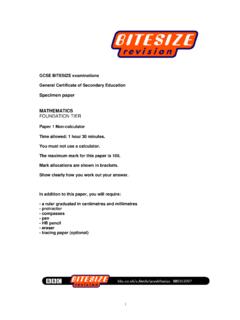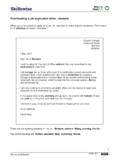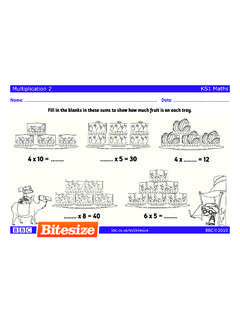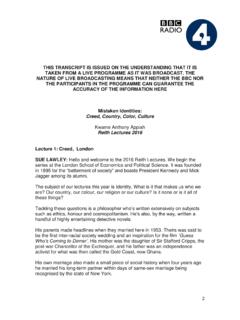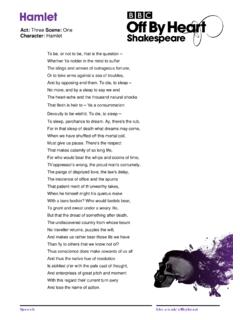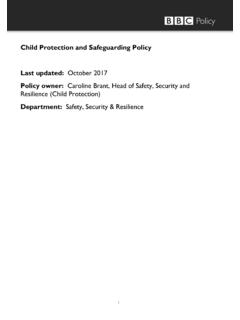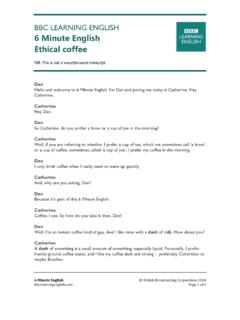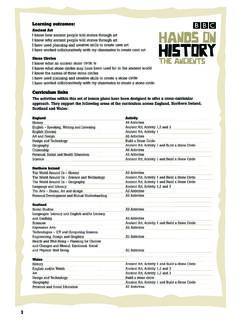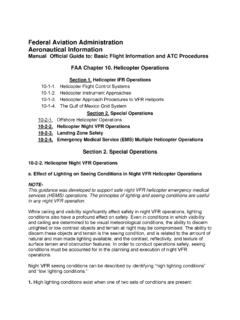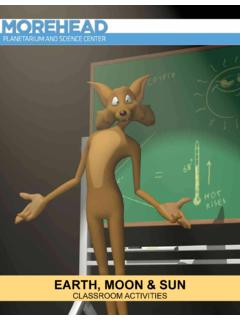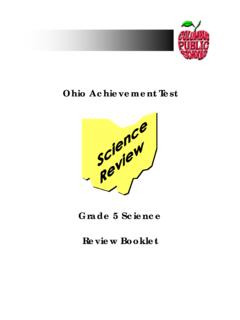Transcription of BBC Stargazing Live: KS2 Lesson plans
1 Lesson PLANSKS2 Stargazing live on BBC Two, presented by Professor Brian Cox and Dara O Briain, brings us the wonders of the galaxy and reveals the mystery of the stars. Many children are fascinated by space, and epic images from the world s best telescopes combined with the excitement of a live event will undoubtedly inspire many help capture this excitement and use it to motivate students, Blue Peter has produced a series of six Stargazing Challenge films in which children work together with Bang Goes the Theory s Jem Stansfield and Helen Czerski to discover the answers to key questions about the universe, including Why do we have Seasons? and Why does the moon appear to change shape in the sky? . Stargazing live has produced this pack of six Lesson plans to accompany the films. Each Lesson includes the film, engaging practical activities for children and clear explanation about the best way to deliver the Lesson . The lessons are designed to be used either separately or in sequence in the order presented in this pack.
2 The films are available at under the Schools tab and on the BBC Learning Zone Class Clips website, challenges at the start of each film, set by Blue Peter presenters Barney Harwood and Helen Skelton, are also available separately, meaning you can show them to your class and discuss how to solve the challenge before watching the full pack is only one part of the Stargazing live offer for schools for 2012. Go to and click on the Schools tab to watch animated astro answers to questions including How big is the biggest star? and to find out how young people made their own music track using sounds collected from the Lovell Radio Telescope at the home of Stargazing live , the Jodrell Bank Observatory in Cheshire. There are also a series of films featuring inspirational space professionals, Jobs with the earth , Sun and moon Scale Model2 earth , Sun and moon Orbits3 Phases of the Moon4 The Seasons5 Rockets6 TelescopesORDER OF Lesson plans IN PACKWORKSHEETS Worksheets to accompany the Lesson plans are included at the end of this Stargazing live 2012 | Lesson plans Introduction | 02 Before you start it is worth reflecting on the sense of sheer amazement that the topic of space can generate in a classroom.
3 The Sun is so large that the earth would fit inside it more than a million times. There are more than 100 billion stars in our galaxy and more than 100 billion galaxies in the of these numbers are so large that they seem to lose their meaning. To help children gain a sense of perspective, ask them about counting. Estimate how long it would take you to count to 1,000 about 12 minutes. How long would it take you to count to a million? If you were to count at a speed of one number per second for 10 hours every day, counting to a million would take you about three weeks. If you think that s a lot of counting, to get to a billion you could count for 12 hours every day and it would still take you more than 50 years. 100 billion? Let s not even don t forget that the universe is so amazingly huge that despite the trillions of stars it contains, it is almost completely empty. The distances between the stars are inconceivably large and the distance between galaxies even DEFINITIONS A billion is 1,000,000,000 a thousand million.
4 The British definition for a billion used to be 1,000,000,000,000 a million million but this number is now referred to as a THE NUMBERSBBC Stargazing live 2012 | Lesson plans Introduction | 03 CURRICULUM LINKSBBC Stargazing live 2012 | Lesson plans Curriculum links | 04 The six Stargazing live Stargazing Challenge films and accompanying Lesson plans create learning opportunities linked to the National Curriculum. References are to the Key Stage 2 National Curriculum for England PLAN 1: SCALE MODEL OF THE earth , SUN AND MOONSc4 Physical Processes 4 The earth and Beyond, 4d ..that the earth orbits the Sun once each year, and that the moon takes approximately 28 days to orbit the earth . Lesson PLAN 2: earth , SUN AND moon ORBITSSc4 Physical Processes 4 The earth and Beyond, 4c, 4d..how day and night are related to the spin of the earth on its own axis. Lesson PLAN 3: PHASES OF THE MOONSc4 Physical Processes 4 The earth and Beyond Stargazing live 2012 | Lesson plans Curriculum links | 05 Lesson PLAN 4: THE SEASONSSc4 Physical Processes 4 The earth and Beyond PLAN 5: MAKING ROCKETSSc4 Physical Processes 2 Forces and motion 2b, 2e.
5 That objects are pulled downwards because of the gravitational attraction between them and the earth ..how to measure forces and identify the direction in which they act. Lesson PLAN 6: TELESCOPESSc1 Scientific Enquiry Investigative Skills 2l. Sc4 Physical Processes 3 Light and Sound 3d.. use scientific knowledge and understanding to explain their observations, measurements or other data or conclusions..that we see things only when light from them enters our eyes. 1 HOUROBJECTIVES: To know that the Sun, earth and moon are approximately spherical To know their relative sizes and the relative distances between themCHILD FRIENDLY OUTCOME: To describe the shape and the size of the earth , Sun and moon and how far apart they are in space FILM CLIPS: Stargazing live Stargazing Challenge film 1 Scale Model of Solar System using fruit BBC Learning Zone Class Clip 1589 (Images of the earth , Sun and moon )RESOURCES: Sticky notes A selection of spheres of different sizes beach ball, football, tennis ball, ping-pong ball, marble, peppercorn, coriander seed, tiny beads Sticky tackSCALE MODEL OF THE earth , SUN AND MOON1 Lesson PLAN INTRODUCTION Show a video montage about space such as BBC Learning Zone Class Clip 1589 (a compilation of images of the earth , Sun and moon , set to music)Ask three or four children to tell the class an interesting fact they know about the earth , Sun or moon (for example it takes eight minutes for light to reach the earth from the Sun).
6 Ask the children what they would like to find out about the earth , Sun and moon . Then ask them to write questions on sticky notes and stick them to a class questions poster. Read out some of the Stargazing live 2012 | Lesson plans Scale model of the earth , Sun and moon | 06TO ACCOMPANY FILM 1: SCALE MODEL OF SOLAR SYSTEM USING FRUITBBC Stargazing live 2012 | Lesson plans Scale model of the earth , Sun and moon | 07 ACTIVITYAsk the children in groups to put the earth , moon and Sun in order of size by choosing from a range of spheres beach ball, football, tennis ball, ping-pong ball, marble, peppercorn, coriander seed, tiny beads. Do the children understand that the Sun is larger than the earth and that the moon is smaller?Choose the largest sphere and explain that it represents the size of the Sun. Ask the children to suggest which sphere might represent the correct size of the earth and then which might represent the size of the moon . (For a 60cm beach ball Sun, the earth is a blueberry and the moon is a coriander seed or tiny bead.)
7 For a 30cm football sized Sun, the earth is a coriander seed or tiny bead and the moon a tiny piece of sticky tack.)Ask the children to hold the earth and the moon stuck on the end of pencils using sticky tack. Ask a third child to hold the Sun. Then ask them to stand in the classroom to show how far apart the earth , Sun and moon are.(For a 60cm beach ball Sun, the earth is 35m away and the moon is less than 1mm from the earth . For a 30cm football sized Sun, the earth is 12m away and the moon is less than 1mm from the earth .)For effect, repeatedly ask the child holding the Sun to move back towards the classroom door until they have to open it and step outside. Alternatively take the class outside, or to the school hall, to demonstrate these distances. Note: The children will probably be surprised by the huge distances compared to the small size of the earth . You could explain that space is called space because there is so much space out there. Explain that it took astronauts three days to get to the moon and it would take several months to get to the Sun even in a rocket travelling at over four miles every ASSESSMENTGive the children long thin strips of paper A4 cut into quarters lengthways.
8 Ask them to make a quick sketch of the earth , Sun and moon . Do the sketches show that the earth and moon are much smaller than the Sun and that they are very far away? PLENARYN eptune, the furthest planet from the Sun, is 30 times further away from the Sun than the earth is. Challenge the children to use this fact to work out how big a model of the whole Solar System would be on the scale used. Explain that one way around this problem is to scale down the distances between the planets but keep the planets to a different larger scale. Explain that this is what has been done in this video. Show Stargazing live Stargazing Challenge film 1 Scale Model of Solar System using fruitEXTENSIONAsk the children to draw a map or picture of the earth in space to show what they understand about how the earth moves, the other planets and anything else in our Solar System. The children can create a scale model of the Solar System using a loo roll and a selection of fruit see Stargazing live Planetary Activity Card number 3/9 at under the How To Guides tab The children can use the Stargazing live Star and moon Guide (Space Stats and How Big is Space?)
9 Pages) and other reference sources to research further Solar System facts and use the information to create a fact fileFURTHER ACTIVITIES 1 HOUROBJECTIVES: To know how day and night are related to the spin of the earth on its own axis To know that the earth orbits the Sun once each year, and that the moon takes approximately a month to orbit the EarthCHILD FRIENDLY OUTCOME: To describe the movement of the earth , Sun and moon and how long these movements take FILM CLIPS: Stargazing live Stargazing Challenge film 2 earth , Sun and moon orbitsRESOURCES: Coloured chalk playground chalk or normal chalkEARTH, SUN AND moon ORBITS2 Lesson PLAN BBC Stargazing live 2012 | Lesson plans earth , Sun and moon orbits | 08 INTRODUCTIONAsk the children in groups to discuss the movements of the earth , Sun and moon and to create a group diagram on large paper using arrows to show movement. (Make it clear that these do not have to be to scale.) Display the diagrams and ask the children to give feedback on each other s work to the whole class.
10 Show Stargazing live Stargazing Challenge film 2 earth , Sun and moon orbitsACTIVITYE xplain to the children that they are going to work in groups to act out the orbits of the earth and moon around the Sun as they have seen in the video. Then each group will perform for the the playground give each group a space to work in and ask them to draw the Sun and the orbit of the earth using the chalk. Ask three or four children to stand on the Sun bending and stretching and waving their arms to represent solar activity. Then ask two children to be the earth facing each other and holding both hands. Ask the earth children to rotate slowly anticlockwise whilst also walking slowly anticlockwise around the Sun. Ask one child to be the moon . Explain that the same side of the moon always faces the earth so they have to orbit the earth walking sideways so they always face towards each group to perform so that the moon orbits the earth whilst the earth orbits the Sun.


